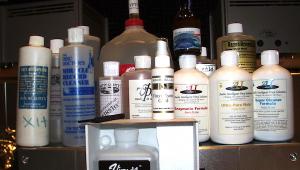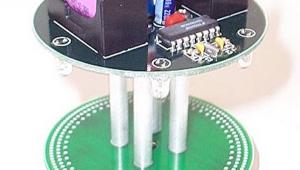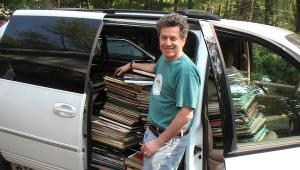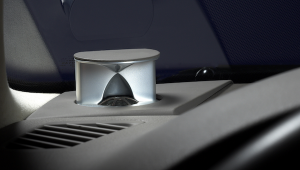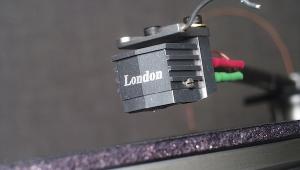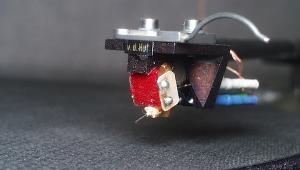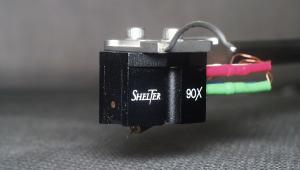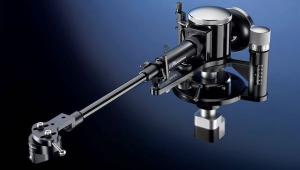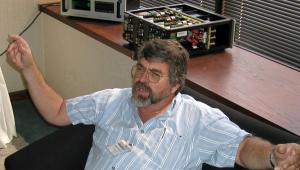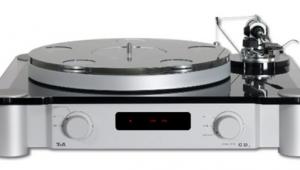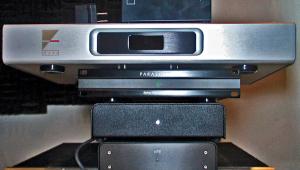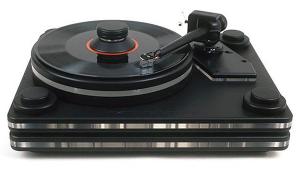Analog Corner #47

(Originally published in Stereophile, June 12th, 1999)
I've been waiting for the right occasion to crack open a sealed-in-the-polyethylene-bag 1A pressing of The Byrds' Mr. Tambourine Man I'd bought a few years ago from a veteran Columbia Records publicist. Today was the day. Wiz reissue producer and Sundazed Records Prez Bob Irwin has just graced me with test lacquers of that album, which he'll release soon on 180gm vinyl, along with Turn! Turn! Turn!, Notorious Byrds Brothers, and Sweetheart of the Rodeo—with others to follow (I hope).
These Irwin-produced sets were issued three years ago to great acclaim on Columbia/Legacy CD (with some cuts, like "Mr. Tambourine Man," mixed analog in stereo for the first time), with lots of great bonus tracks, photos, studio chatter, etc. The new LPs, mastered all-analog using Irwin's custom-rebuilt Ampex ATR-100 playback deck, will contain the remixes, plus one bonus track per side, fitted in without compression. The plan is to issue the LPs with gatefold jackets to allow the inclusion of never-before-seen photos from the original sessions and other cool stuff.
The sound from the lacquer demolished the original LP (not to mention the 20-bit SBM CD) in terms of dynamics and resolution of inner detail, but timbrally and otherwise, as you might hope, the integrity of the original mix and mastering has been preserved. The bonus tracks on the first LP are "She Has a Way" and the instrumental "You and Me''—a treat for fans of McGuinn's Rickenbacker 12-string fretwork.
Sundazed's catalog has many other great 180gm vinyl reissues, including Albert King's Stax/Volt classic Born Under a Bad Sign. Check it out! (www.sundazed.com)
Tuner Fishing
"I knew Don Scott, and you're no Don Scott."
True. Scott used to write technically informed tuner reviews for Stereophile, and I am no Don Scott. But I'm going to write about FM here anyway, if only for a short spell. The signal, after all, is analog.
How many audiophiles listen to the radio through their hi-fis anymore? Few, I bet. FM radio, once an audiophile haven rich with classical music stations and live broadcasts—especially in the early '60s, at the inception of FM multiplex stereo broadcasting—today more closely resembles the steaming pit of garbage AM had become by the time of FM's ascendance.. AM, of course, has become worse: a viper's nest of kook political and religious talk-radio shows, all-news stations ("give us 20 minutes and we'll tell you absolutely nothing—over and over again'').
Many younger audiophiles, brought up on a diet of cheap, phase-locked-loop digital tuners and stations that play tricks with the signal to make it "punch through" and attract dial scanners, have never heard how good FM can sound. Station engineers who took pride in the sound quality of their signals have given in to the demands of advertising departments and the bottom line. And the "pro audio" CD players used at most stations don't help.
Nonetheless, if you're fortunate enough to have an adventurous college radio station or three in your area, or the occasional gem of a commercial or listener-supported station, FM can be musically and sonically rewarding. Most such stations not only don't compress their signals, they are conscientious about trying to sound good. You can hear live concert broadcasts on some, and even decent vinyl playback.
Unfortunately, many college radio stations—located on the crowded left side of the dial between 88 and 92—are seriously underpowered. Unless you're close to the transmitting tower, they're often difficult to pick up.
I live not far from WFMU, an eclectically programmed treasure of a station formerly associated with Upsula College, an institution that unfortunately went downsula. The station then reinvented itself as an independent entity. Today, thanks to savvy management, the dedication of the volunteers who staff it, and generous listener support, WFMU is alive and well. But reception, especially in stereo, is problematic, and I can't be more than 10 or 15 miles from the transmitter.
So when I picked up a nice McIntosh MR67 vacuum-tube tuner (ca 1963–68) at a garage sale for $50 a few years ago, I decided to get my FM act together. I called Steve Rowell at Audio Classics (www.audioclassics.com) in Vestal, New York (near Binghamton, home of McIntosh), and arranged to have the unit restored by Richard Modafferi, the original designer of many McIntosh tuners and now employed by Audio Classics.
My tuner was overhauled to factory specs (or better) and modified with new caps, output signal wire, and Cardas jacks. I also scored an original wooden cabinet. Most important, I bought a rotor and Channel Master FM antenna, which I had installed on my roof by a local specialist—a colorful, pre–cable-TV vet. While he was up there, I had him hang a VHF/UHF antenna as well. Local stations look and sound so much better than they do on cable!
The sound of the MR67 is intoxicating: rich, warm, detailed, expansive, and quiet. I keep thinking of the guy who sold it to me, telling me all about his Kenwood receiver's digital PLL tuner and how much better it was—but if I wanted to take that old thing off his hands, I could have it for $50! I'm sure the Mac MR78 I got for nothing at another garage sale (long story) is technically better, but the romance lives in the tubes.
The rotor-antenna combo sucks in stations from all over the dial like a vacuum cleaner. I can sometimes pick up different signals on the same frequency by rotating the antenna. I've logged stations from the southernmost parts of New Jersey, the tip of Long Island, and Connecticut, some from small towns I've either never heard of or never expected to pick up with an FM radio. Some nights I'll just sit down and fiddle with the rotor and the tuner dial to see what I can pull in. Now that's entertainment! Who needs the Internet?
More important, I can now dial in WNYC, WFMU, WFUV, WKCR, WBGO, and other great metropolitan-area stations, all free of noise and multipath distortion. These stations feature eclectic programming, live concerts, special events, and radio personalities who actually have personalities. I've "downloaded" hours of great free non-MP3 music to MiniDisc. The investment in the tuner, restoration, and antenna-rotor have more than paid for themselves.
With a vintage tuner, or even a new one from Stereophile's "Recommended Components" list, the key is a good antenna. With rotors going for about $70 at RadioShack, and good FM antennas priced about the same, you can be up and running for a few hundred bucks.
Another radio
Someone once told me that, every year, Bose spends more money to advertise and promote its Wave radio than the entire "specialty" audio industry combined devotes to promoting all of its products. Is that true? I don't know, but I wouldn't be surprised. Anyone who believes the hyperbole attached to Bose's advertising of thaT plastic radio—that it gives you "concert hall" sound, and that it equals the sound of an entire rack of components—deserves what they get.
No doubt when you pay $399, or whatever Bose charges for the Wave, you're paying big time for the advertising campaign built into the cost. Hey! Maybe it's just as well that "high-end" audio companies don't advertise quite as much.
I've heard the Bose Wave, and it's a pretty good little radio. But Henry Kloss's new Model 88, available from Cambridge SoundWorks, is a much better radio at half the price: $199.99. Kloss has always been a hero to me, and to millions of audiophiles who grew up in the 1950s, '60s, and '70s with AR, KLH, and Advent products. So when I ran into him at the taping of The History of Audio last summer (the program premiered on the History Channel last December and is in regular rotation), it was a charge. But when he called me to ask if I'd like to hear his new radio, it made me all tingly inside. The answer, of course, was "Yes!" The Model 88 arrived the next week.
Kloss revolutionized the radio market with the original KLH Model Eight back in 1963—a genuine hi-fi classic that you can sometimes find at garage sales, if you're lucky. Using frequency contouring (equalizing the signal to compensate for the deficiencies of the loudspeaker), Kloss got a very small speaker to sound BIG. He used the same technique in his "stereo in a suitcase''—another classic that put a long-overdue knife in the heart of the pull-down-changer/flip-out-speaker stereos found in college dorm rooms in the late '60s. After issuing the Advent 400 in 1974—another classic radio, though not nearly as cool-looking as the Model Eight—Kloss inexplicably left the FM radio market. Guess who jumped in?
So, for what he told me was his final project before retiring, Kloss is back with the Model 88—a compact (14" by 43⁄4" by 81⁄8"), neat-looking stereo radio with a built-in, front-ported, 4" long-throw "subwoofer." Kloss told me that to get both the sound and the tuner performance he wanted, he couldn't use an off-the-shelf tuner chip; the Model 88's tuner is built from discrete parts.
The remote-controlled 88 sports an AM/FM tuner (with a good-sounding, wideband AM section), two Aux inputs (for a CD player, tape deck, or even a computer), a 12V DC power jack for use on boats, and an F-connector for an external antenna. There are six AM and six FM presets. The 88 is not a clock radio, but there is a clock option that will turn the radio on from across the room via infrared remote.
The 88 pulls! Using just a wire stuck in the F-connector, I got WBGO and WFMU—a feat a number of expensive A/V receivers couldn't pull off. The 88 logged an impressive roster of local and not-so-local stations using just the wire.
"Concert-hall" sound? "Replace an entire wall of components''? Hell no, but Kloss doesn't make such absurd claims. The sound of the Model 88 is impressively robust—especially the bass, given the radio's small size—and since you can adjust the bass level, you can achieve a pleasing balance wherever you end up placing the radio. The 88 can sound somewhat hard if you crank it, but at reasonable volume it sounds pleasingly rich and full-bodied. And it will play loud without distorting. I measured dynamic peaks of well over 100dB on a Gershwin piece broadcast over WQXR, and there was plenty of headroom left; the 88 wasn't breaking a sweat.
Kloss has created a great final product—especially given its $200 price. (Available from Cambridge SoundWorks, (800) 367-4434.) Thanks for 45 years of great audio products, Henry, and enjoy your retirement!
Wally plays with a full deck
The redoubtable Wally Malewicz has been doing some research on the variability of phono cartridges' vertical tracking force (VTF) relative to their stylus height, and he's come up with some interesting measurements. With the Graham 2.0 arm, for instance, 2 grams measured with the stylus at the record surface became 2.1gm at 2mm above the record surface, and 2.2gm at 4mm above the record surface. Fulcrum-type stylus-pressure gauges like the inexpensive Shure place the stylus about 5mm above the record surface. To set VTF accurately, Wally recommends setting the gauge on a stack of playing cards next to the platter, and using as many cards as needed to level the gauge beam with the edge of the record.
The Graham isn't the only arm whose VTF changes with the distance above the record surface. Wally measured a Wilson-Benesch arm and found that 2gm at the record became 2.15gm at 2mm above, and 2.30gm at 4mm above! The Immedia and VPI JMW, both of which have large masses well below the pivot point, also show this kind of variation.
Each of the three Wally Scales sold by Malewicz now comes with a deck of cards. Two of Wally's scales are electronic, with digital readouts, and are accurate to 0.1 and 0.02gm. The third, accurate to 0.05gm, is a balance-beam type that uses a high-quality unipivot bearing.
Wally lugged his oscilloscope and Audio-Technica cartridge analyzer to The 1999 CES to demonstrate to me the necessity of antiskating provisions on a pivoted arm—not that I needed convincing. First he played a track from the A-T test record, with antiskating applied to the Graham arm. Both right and left sinewaves were reproduced without visible distortion. Then he disabled the antiskating and played the tracks again. This time the right channel was clearly distorted, with jagged spikes at the tops and bottoms of the waves, indicating that the stylus was losing contact with the groove. This is why I'm uncomfortable with pivoted arms that don't feature antiskating. How can distortion sound "better''?
Motor Drive Wars!
In last November's column, I wrote about the very effective $1500 Walker Precision Isolated Power Motor Drive, which can be used with any turntable using an AC synchronous motor. Shortly thereafter I received VPI's $1000 SDS motor drive, which replaces the PLC controller VPI used to supply with TNT turntables, and which also works with any 'table driven by an AC motor.
I've lived with the SDS for a few months, and it's a very effective device that includes a number of unique features. Like the Walker drive, the SDS provides a precise, stable, highly filtered, amplified, pure sinewave that causes the turntable motor to turn more precisely. The result is greater overall musical authority, including tighter bass, cleaner transients, and better attacks.
The SDS's variable-frequency generator allows you to precisely adjust the motor speed so you can spin the record at exactly 331/3rpm, 45rpm, or anyplace in between. Any platter or pulley machining errors that might cause the speed to be slightly off can be corrected. You can control both output voltage (eight values between 72 and 115V) and frequency (52–66Hz for 331⁄3rpm, 71–90Hz for 45rpm). The unit outputs 115V at startup, then quickly drops to a lower voltage, which generates less electrical noise and results in smoother operation.
The SDS comes factory-set for 72V operation—its lowest setting—which is sufficient to bring VPI 'tables up to speed and keep them there. Other voltages can be chosen via a calibration mode. This allows the front-panel controls to access other functions, including telling you how many times the unit has been turned on and off since it was built, and, more important, how many hours it has run. That can be very helpful in keeping tabs on how many hours of play your cartridge has logged—assuming you don't leave your motor spinning for long periods without playing records.
When you switch on the SDS, the voltage and frequency settings light up via green front-panel LEDs. You can vary the frequency up or down in 0.01Hz increments. A 33/45 switch allows you to change speeds without moving belts and pulleys, and each speed has its own frequency and voltage parameters.
While the Simon Yorke Precision Analogue Disc Transcription System required more than 72V to start on its own—probably due to its 24-lb platter and small motor—I left the unit set to 72V and used my hand to bring the system up to speed. After all, playing records should be a hands-on experience.
Like the Walker drive, the SDS cleaned up the Yorke's sound in subtle but significant ways, and made playing 45s somewhat more convenient—no belt to change. I also like the idea of being able to dial in 331⁄3 with ultra-precision, though the Yorke's machining tolerances are virtually spot-on.
Which drive did I prefer? I can't answer that—the Walker went back for revision over a month ago, and just came back today. The revision included front-panel speed adjustment (before, you had to open the chassis) and a motor phase switch. These changes make the Walker control almost as convenient as the VPI, but at $500 more, it should offer better sound to be competitive. I'll let you know what I hear next time.
Lewis Electronics Remote Polarity Control
Absolute polarity. Can you hear it? It's easy enough to find out. Play a simply miked recording and listen carefully. Then shut your system down and reverse speaker leads on both channels. Listen again. Try this with a few records. Maybe you'll hear that one position gives you more air, cleaner reverberation, better dynamics, etc. Maybe you'll hear nuthin'.
The idea is that playback should be in phase with recording—your speaker should push air into your room—a compression—at the same points in the musical waveform that air was pushed at the microphone diaphragm. If the recording and playback are out of absolute phase, your speaker will be in its rarefaction phase—ie, going in the opposite direction—when it should be compressing. Noted audio fanatic, audio retailer, and 78rpm playback specialist Clark Johnsen has even written a book about this subject, entitled The Wood Effect (available from Audio Advisor and other sources or direct from the author at The Modern Audio Association, 23 Stillings Street, Boston, MA 02210. Tel: (617) 357-8040).
If you hear the difference when switching phase back and forth, you'll be happy to know that the Lewis Electronics Company (5675 SW 74th Avenue, Miami, FL 33143, (305) 667-2601) sells a $600 device that allows you to switch LP absolute phase from your listening position via a wireless-remote-controlled phase-inversion box. You plug your phono cables into the box, and the box into your preamp phono stage (using the supplied short jumper cable). The box, controlled by a transmitter and receiver, instantly reverses both leads, using what sound like relays, gears, and switches. Build quality is strictly RadioShack, but the interconnect jumpers are of very high quality, physically and sonically.
As long as your phono stage input impedance is 500 ohms or below, you shouldn't hear clicking or popping. I didn't. Nor did I hear any differences I could be sure of, using minimally miked recordings like the Fritz Reiner/CSO Also sprach Zarathustra from 1954 (RCA LSC-1806), Ustad Ali Akbar Khan's Sarod (Water Lily Acoustics WLA ES-01), and J;aanos Starker's set of the Bach Suites for Solo Cello (Mercury Golden Import SRI3-77002). I also heard no perceivable "loss" with the box between the phono cables and preamp input, which is a good thing (Footnote 1).
Apparently, some folks are more sensitive than others to differences in absolute phase. I suggest trying it at home; if you hear a difference that's important to you, consider the Lewis device. Just remember: If you load your cartridge with 47k ohms, you may hear pops when switching.
Next time...
Multi-cartridge survey, Thorens' three-speed TD 295 Mk.2 turntable, Kuzma's Stabi S turntable/arm, and Pagode and Zoethecus stands.
Footnote 3: Note that this will only work with a phono cartridge as source. Swapping hot for ground will not invert absolute polarity for an active source like a CD player or FM tuner.—JA
